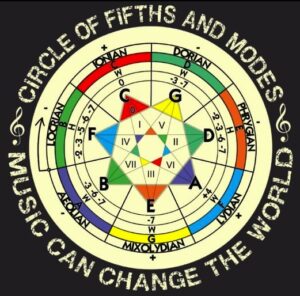So you’ve strummed your way through the pentatonic scale, rocked out with the blues scale, and even dabbled in a little harmonic minor. But now, it’s time to take your guitar skills to the next level and conquer the mysterious world of modal scales. No need to fret (pun intended), because we’re here to guide you through mastering modal scales on the guitar. So grab your axe, tune up those strings, and get ready to unlock a whole new realm of musical magic. Let’s dive in, shall we
Contents
- 1 Understanding the Basics of Modal Scales
- 2 Exploring the Major Modes: A Starting Point
- 3 Diving Deep into Dorian: Techniques and Applications
- 4 Mastering Mixolydian: Unique Characteristics and Uses
- 5 Lydian Mode: Unlocking Its Ethereal Sounds
- 6 Phrygian Mode: Embracing the Exotic
- 7 Practicing Modal Scales: Methods and Tips for Guitarists
- 8 FAQs
- 9 Rock On with Your Modal Scales!
Understanding the Basics of Modal Scales
So you wanna dive into the world of modal scales, huh? Well buckle up, because things are about to get jazzy! Modal scales are like the cool, hip cousin of your regular old major and minor scales. They add a little extra spice and flavor to your playing, making you sound like a true musical genius.
Now, before you start shredding some epic modal solos, it’s important to understand the basics. Here’s a crash course in modal scales that will have you sounding like a pro in no time:
- Know your modes: There are seven modes in total, each with their own unique sound and vibe. From the mysterious Aeolian mode to the dreamy Dorian mode, each mode brings something special to the table.
- Start with the major scale: The easiest way to understand modal scales is to think of them as variations of the major scale. Each mode is built off a different degree of the major scale, giving it a distinct sound.
- Experiment with different modes: Don’t be afraid to mix things up and try out different modes in your playing. You never know what kind of magic you might create!
So there you have it, a crash course in the wild world of modal scales. Now go forth and unleash your inner modal master!

Exploring the Major Modes: A Starting Point
So you’ve decided to take on the challenge of exploring the major modes in music. Congratulations! You’re about to embark on a journey that will take you from the depths of darkness to the heights of brightness, and everywhere in between. Get ready to unleash your inner musical wizard!
Before you dive in headfirst, it’s important to understand the basics. The major modes are seven unique scales that each have their own distinct personality. From the mysterious Aeolian mode to the flamboyant Mixolydian mode, each mode brings something new to the table. Think of them as a quirky group of friends at a party – each with their own quirks and charms.
Now, it’s time to start dipping your toes into the major mode pool. Here are a few tips to help you get started:
- Start with the tried-and-true Ionian mode - it’s like the vanilla ice cream of the major modes. Safe, reliable, and always a crowd-pleaser.
- Experiment with different chord progressions to see how each mode interacts with them. You might stumble upon some unexpected musical magic!
- Don’t be afraid to make mistakes – that’s how you learn and grow as a musician. Embrace the chaos and let your creativity run wild!

Diving Deep into Dorian: Techniques and Applications
Ready to take a plunge into the world of Dorian? Let’s dive deep and explore the techniques and applications that make this musical mode a real treasure trove!
First things first, when it comes to navigating the waters of Dorian, it’s important to understand its unique characteristics. Dorian is like the rebellious teenager of the music world – it combines the major scale with a flatted third and seventh, giving it a mysterious and slightly moody vibe. So throw on your leather jacket and get ready to rock out with some seriously cool, minor-infused jams!
Now, when it comes to applying Dorian in your own music, the possibilities are endless. Whether you’re looking to add a touch of sophistication to your compositions or want to inject some soulful groove into your solos, Dorian has got your back. And don’t forget to experiment with different modes and scales to really make your music stand out – after all, variety is the spice of life!
So, grab your diving gear and get ready to explore the depths of Dorian. With a little creativity and a whole lot of attitude, you’ll be making waves in no time!

Mastering Mixolydian: Unique Characteristics and Uses
In the world of music theory, there are few scales as intriguing as Mixolydian. With its unique characteristics and exciting uses, mastering this scale can take your compositions to a whole new level!
One of the most distinctive features of Mixolydian is its dominant 7th note, giving it a slightly bluesy sound that sets it apart from other modes. This characteristic makes it perfect for adding a touch of edge to your melodies and creating tension that resolves beautifully.
When it comes to using Mixolydian in your music, the possibilities are practically endless. Whether you’re looking to spice up a funky bassline, add some flair to a guitar solo, or give your chord progressions a fresh twist, this scale has got you covered. The versatility of Mixolydian makes it a favorite among many musicians looking to inject some excitement into their pieces.
So, grab your instrument of choice, dive into the world of Mixolydian, and discover the endless creative possibilities that this unique scale has to offer. Let your imagination run wild and watch as your music comes alive with a touch of Mixolydian magic!

Lydian Mode: Unlocking Its Ethereal Sounds
The Lydian mode is like the mysterious cousin of the major scale, with a touch of otherworldly charm that can transport your music to new and ethereal heights.
With its raised fourth scale degree, the Lydian mode has a dreamy quality that can make your melodies soar like a majestic eagle… or at least a seagull on a particularly breezy day.
Here are some tips to unlock the ethereal sounds of the Lydian mode:
- Experiment with chord progressions: The raised fourth scale degree in the Lydian mode can create some interesting chord progressions that sound like they’re straight out of a fairy tale.
- Use open strings: The Lydian mode loves open strings, so let them ring out and add to the mystical vibe of your music.
- Play with dynamics: The Lydian mode is perfect for creating dynamic contrasts in your music. Go from whisper-quiet to thunderously loud and watch your audience get swept away on a magical journey.
Phrygian Mode: Embracing the Exotic
So you’ve decided to venture into the musical realm of the Phrygian mode, huh? Well, buckle up because things are about to get exotic! Don’t worry, this isn’t your typical diatonic scale – the Phrygian mode is like the spicy curry of musical modes, with an exotic flair that will transport you to a place where camels roam free and belly dancers reign supreme.
Embracing the Phrygian mode means opening your ears to a whole new world of musical possibilities. With its unique combination of half steps and whole steps, this mode will have you feeling like you’ve been transported to a bustling bazaar in ancient Persia. Picture yourself swirling in a whirlwind of Middle Eastern melodies, where each note is like a precious gem waiting to be discovered.
When you dive into the Phrygian mode, you’ll encounter the mysterious and enigmatic nature of its sound. The flat second scale degree gives it a dark and haunting quality, perfect for setting the mood in your compositions. So go ahead, let your inner Sultan or Sultana shine through as you explore the intoxicating sounds of this ancient scale.
In conclusion, the Phrygian mode is not for the faint of heart. It’s bold, exotic, and unapologetically dramatic. So grab your oud, don your fez, and get ready to embark on a musical journey like no other. Embrace the exotic allure of the Phrygian mode and let its mesmerizing melodies transport you to a world where the music is as spicy as the curry and as rich as the tapestries that adorn the sultan’s palace.
Practicing Modal Scales: Methods and Tips for Guitarists
So you’ve decided to delve into the world of modal scales on the guitar. Congratulations! It’s a bit like opening Pandora’s box, except instead of unleashing chaos and destruction, you’re unleashing some sick new sounds.
One method for practicing your modal scales is to start slow and gradually increase your speed. Kind of like training for a marathon, except instead of running you’re shredding on the guitar. Imagine a cheesy ’80s training montage playing in the background as you go from slow and steady to lightning fast.
Another tip is to focus on one modal scale at a time. Don’t overwhelm yourself by trying to learn them all at once. Take it step by step and soon enough you’ll be a modal master. It’s like eating a buffet – you wouldn’t try to sample everything at once, would you? Actually, scratch that. Go ahead and try to sample everything at once. It’ll be hilarious.
And remember, the most important thing is to have fun with it. Modal scales can be tricky, but they can also be incredibly rewarding once you start to master them. So grab your guitar, crank up the distortion, and get ready to impress everyone with your newfound modal knowledge. Rock on, my fellow guitarists!
FAQs
What are modal scales and why should I learn them?
Modal scales are like the secret sauce that adds flavor to your guitar playing. Learning them opens up a whole new world of unique sounds and melodic possibilities that will take your playing to the next level.
How do I master modal scales on the guitar?
It’s all about practice, my friend. Start by familiarizing yourself with the seven modal scales (Ionian, Dorian, Phrygian, Lydian, Mixolydian, Aeolian, Locrian) and practice them in all positions on the fretboard. Get comfortable with the unique intervals and characteristics of each mode to truly master them.
Any tips for memorizing modal scales?
Repetition is key! Practice playing each mode over backing tracks or chord progressions to help cement them in your memory. You can also try visualizing the patterns on the fretboard or using mnemonic devices to remember each mode’s unique sound.
How can I incorporate modal scales into my solos?
Experiment with using different modal scales over different chords to create tension and resolution in your solos. Don’t be afraid to mix and match modes to create interesting and dynamic melodic phrases that will captivate your audience.
Are there any common mistakes to avoid when learning modal scales?
Avoid getting stuck in a rut by only relying on one or two modal scales. Make an effort to explore all seven modes and experiment with incorporating them into your playing. Additionally, make sure to use proper technique and ear training to ensure you’re playing the modes correctly and in tune.
Rock On with Your Modal Scales!
Congratulations, you’ve now unlocked the secret to becoming a guitar god! With mastery of modal scales, you’ll be shredding like never before and wowing audiences with your musical prowess. So go forth, practice diligently, and remember – when in doubt, just add more distortion! Keep on rocking and never stop improving. Cheers to your future guitar hero status!



